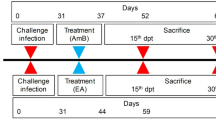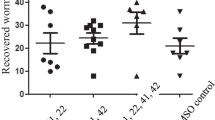Abstract
Deoxyfloxacrine derivatives (1-hydrazone: S 83 0083; 1-imine: S 84 7277) and floxacrine derivatives (10-methoxy-floxacrine: L 84 7667; 1-imine: L 84 7693) selected from a series of newly synthesized 3-aryl-7-chloro-3,4-dihydro-1,9(2H, 10H)-acridinediones were evaluated for blood schizontocidal activities in mice infected with asexual stages of various drug-resistant lines ofP. berghei and in New World monkeys infected with blood schizonts of different chloroquine-resistant strains ofP. falciparum. All compounds tested showed high activity against drug-resistant lines ofP. berghei (ED50: 1.0–4.4 mg/kg×5, per os) and were distinctly superior in their antimalarial potency to floxacrine. Compounds L 84 7667 and L 84 7693 proved to be highly active against the FCBR strain ofP. falciparum in vitro (IC50: 0.73–1.78 nmol); they effected temporary clearance of parasitemias due to the Palo Alto strain ofP. falciparum in squirrel monkeys at oral doses of 15 mg/kg given daily for 5 consecutive days. Compounds S 83 0083 and S 84 7277, showing moderate in vitro effects (12.9–24.8 nmol), cleared parasitemias of the FCBR strain ofP. falciparum in owl monkeys at oral doses of 20 mg/kg (S 84 7277) given daily for 5 or 7 consecutive days (follow-up period, 17 and 30 days, respectively) or at doses of 20 mg/kg (×4) (S 83 0083) followed by doses of 40 mg/kg (×3) within a follow-up period of 30 days. These observations suggest that the range of doses required for the cure of establishedP. falciparum infections is probably too large to cover infections with strains of the least susceptibility and might evoke toxic reactions by the potential candidates tested.
Similar content being viewed by others
References
Chatterjee DK, Dhar RK, Dutta AK, Iyer SN, Lepcha D, Souza NJ de, Rupp RH (1987) Antimalarial activity of L 84 7667. Trop Med Parasitol 38:246
Desjardins RE, Canfield CJ, Haynes JD, Chulay JD (1979) Quantitative assessment of antimalarial activity in vitro by a semiautomated microdilution technique. Antimicrob Agents Chemother 16:710–718
Dhar R, Desai P, Chatterjee DK, Rupp RH, Souza NJ de (1988) European patent application 0 254 225. Chem Abstr 108:662 (No. 204514 d)
Dürckheimer W, Raether W, Seliger HG (1975) German patent DS 2,337,474. Chem Abstr 83:9827w
Dürckheimer W, Raether W, Seliger H, Seidenath H (1980) 10-Hydroxy-3,4-dihydroacridine-1,9(2H, 10H)-diones, a new group of malaricidal and coccidiostatic compounds. Arzneim-Forsch/Drug Res 30:1041–1046
Gysin J, Hommel M, Pereira da Silva L (1980) Experimental infection of the squirrel monkey (Saimiri sciureus) withPlasmodium falciparum. J Parasitol 66:1003–1009
Knapp B, Shaw A, Hundt E, Enders B, Küpper HA (1988) A histidine alanine rich recombinant antigen protectsAotus monkeys fromP. falciparum infection. Behring Inst Mitt 82:349–359
Maier WA, Raether W, Winkelmann E, Becker-Feldmann H, Unkrig C, Sommerfeld A, Seitz HM (1987) Causal prophylactic action of new acridone derivatives againstPlasmodium yoelii nigeriensis in mice. Trop Med Parasitol 38:270–271
Perrin LH, Loche M, Dedet J-P, Roussilhon C, Fandeur T (1984) Immunization againstPlasmodium falciparum esexual blood stages using soluble antigens. Clin Exp Immunol 56:67–72
Peters W (1970) The chemotherapy of rodent malaria: XII. Substituted tetrahydrofurans, a new chemical family for antimalarials. The action of 2-(p-chlorophenyl)-2-(4-piperidyl)-tetrahydrofuran againstPlasmodium berghei andPlasmodium chabaudi. Ann Trop Med Parasitol 64:189–202
Raether W, Dürckheimer W (1978) Structure-activity relationships in a chemically new series of 10-hydroxy-3,4-dihydroacridine-1,9(2H, 10H)-diones with malaricidal and coccidiostatic properties. 4th International Congress on Parasitology, Warsaw. Short communications, section D, pp 105–106
Raether W, Fink E (1979) Antimalarial activity of floxacrine (HOE 991): I. Studies on blood schizontocidal action of floxacrine againstPlasmodium berghei, P. vinckei andP. cynomolgi. Ann Trop Med Parasitol 73:505–526
Raether W, Fink E (1982) Antimalarial activity of floxacrine (HOE 991): II. Studies on causal prophylactic and blood schizontocidal action of floxacrine and related dihydroacridinediones againstPlasmodium yoelii andP. berghei. Ann Trop Med Parasitol 76:507–516
Raether W, Mehlhorn H (1984) Action of a new floxacrine derivative (S 82 5455) on asexual stages ofPlasmodium berghei: a light and electron microscopical study. Zentralbl Bakteriol Parasitenkd Infektionskr Hyg Abt Orig Reihe A 256:335–341
Schmidt LH (1978a)Plasmodium falciparum andPlasmodium vivax infections in the owl monkey (Aotus trivirgatus): II. Responses to chloroquine, quinine, and pyrimethamine. Am J Trop Med Hyg 27:703–717
Schmidt LH (1978b)Plasmodium falciparum andPlasmodium vivax infections in the owl monkey (Aotus trivirgatus): III. Methods employed in the search for new blood schizonticidal drugs. Am J Trop Med Hyg 27:718–737
Schmidt LH (1979) Antimalarial properties of floxacrine, a dihydroacridinedione derivative. Antimicrob Agents Chemother 16:475–485
Trager W, Jensen JB (1976) Human malaria parasites in continuous culture. Science 193:673–675
Werbel LM (1982) US patent 4,291,034. Chem Abstr 96:66114
Werbel LM, Hung J, McNamara D, Ortwine DF (1985) 3-Aryl-7-chloro-3,4-dihydro-1,9(2H, 10H) acridinedione, 1-hydrazones as potent antimalarial agents (1,2). Eur J Med Chem Chim Ther 20:363–370
Winkelmann E, Raether W (1987) Antimalarial and anticoccidial activity of 3-aryl-7-chloro-3,4-dihydroacridine-1,9(2H, 10H)-diones: 1-imines, 1-amines, 1-oximes, 1-hydrazones and related compounds. Arzneim-Forsch/Drug Res 37:647–661
Author information
Authors and Affiliations
Rights and permissions
About this article
Cite this article
Raether, W., Enders, B., Hofmann, J. et al. Antimalarial activity of new floxacrine-related acridinedione derivatives: studies on blood schizontocidal action of potential candidates againstP. berghei in mice andP. falciparum in vivo and in vitro. Parasitol Res 75, 619–626 (1989). https://doi.org/10.1007/BF00930959
Accepted:
Issue Date:
DOI: https://doi.org/10.1007/BF00930959




